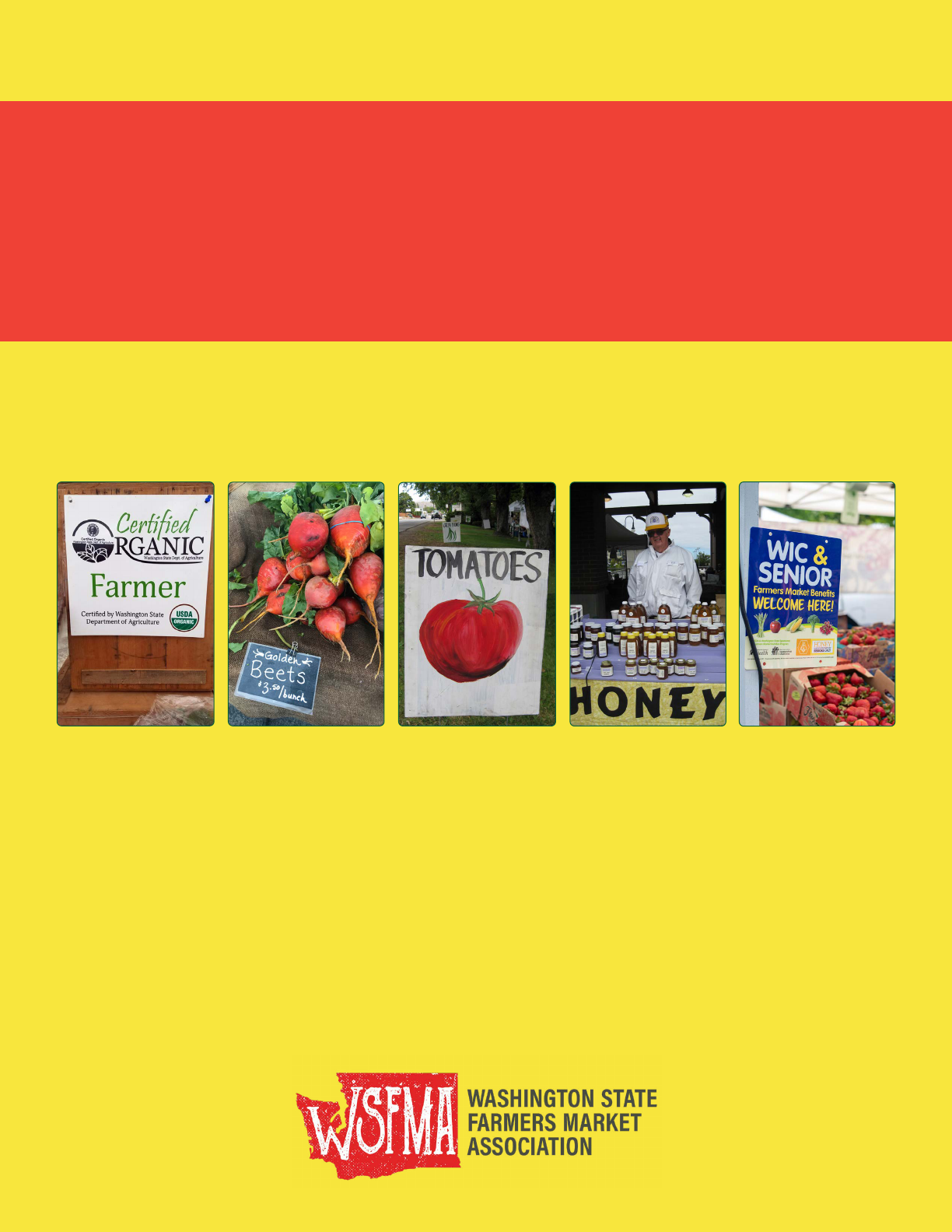
Guide to
Fresh Produce Signage Standards
and Organic Integrity
at Farmers Markets
FIRST EDITION 2021
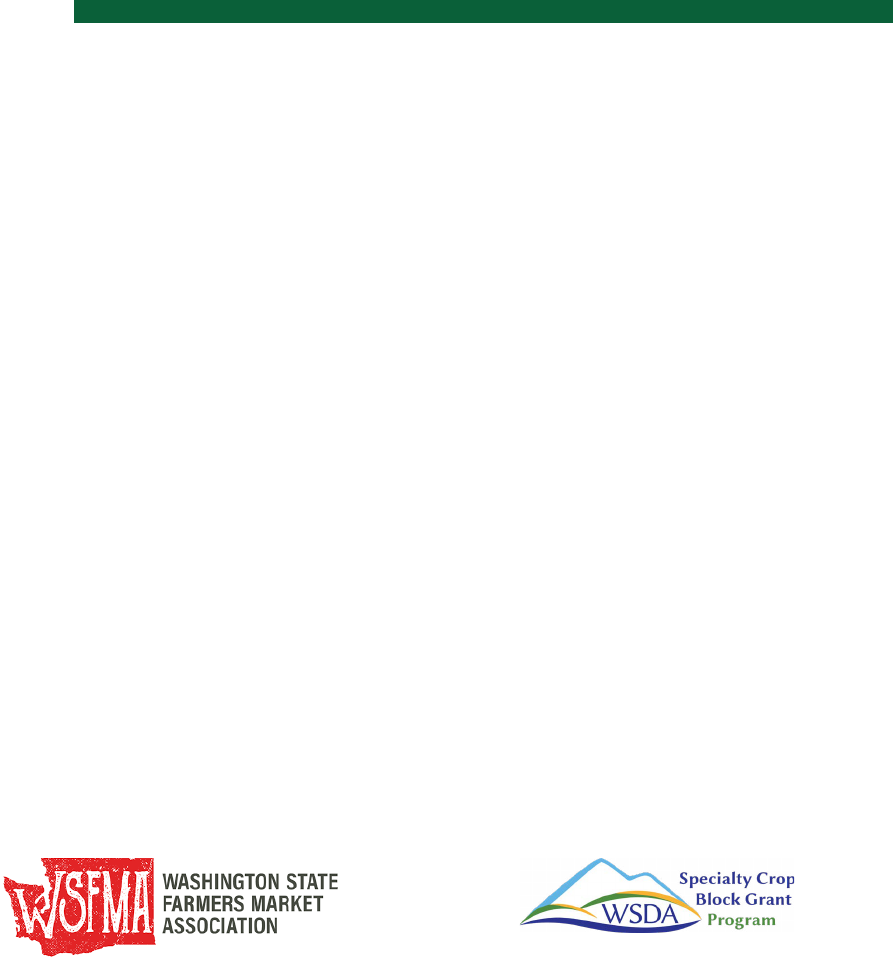
CONTENTS
LEGAL FRAMEWORKS .....................................................................1
Honest Communication at Farmers Markets ..................................................1
Consumer Protection ....................................................................3
Food Safety Modernization Act (FSMA) and Direct Marketing Signage Requirement .................4
Marketing Orders and Agreements .........................................................5
ORGANIC CERTIFICATION AND CLAIMS .....................................................6
Organic Certification and Labeling ..........................................................6
Role of Farmers Market Managers in Organic Integrity ..........................................9
Role of Certified Organic Farmers .........................................................10
Organic Signage and Product Labeling at Farmers Markets .....................................11
Problematic Claims and Signage ..........................................................12
SIGNAGE SPECIFIC TO WASHINGTON FARMERS MARKETS .....................................13
Washington State Farmers Market Association “Roots Guidelines” ...............................13
Payment and Food Access Signage ........................................................14
SIGNS THAT WORK AT THE MARKET BOOTH ................................................17
Farmers Market Booth Signage Check List ..................................................18
Tips for Effective Signs and Banners .......................................................19
QUICK REFERENCE GUIDE ................................................................23
Guide to Fresh Produce Signage Standards
and Organic Integrity at Farmers Markets
First Edition, 2021
Colleen Donovan, Washington State Farmers Market Association
Heidi Peroni, Washington State Department of Agriculture
This guide is made possible by a grant from the WSDA Specialty Crop Block Grant Program.
We gratefully acknowledge the contribution of all reviewers. All photos contributed by authors.

Guide to Fresh Produce Signage Standards
and Organic Integrity at Farmers Markets
The purpose of this Guide is to ensure that all farmers market organizers and specialty crop vendors have the
information they need to communicate effectively with shoppers and to follow legal, industry, and voluntary
standards. As so much communication is through signage, this guide focuses on standards for farmers market
banners, A-boards, vendor booth banners, price signs, and other written collateral at the point of sale. Signage
touches on a range of consumer protection laws, rules for organic certification, as
well as food safety requirements. In addition, farmers markets and vendors now
manage a host of ways to pay, from credit/debit, to EBT and other food access
programs, to “market bucks” and even mobile payment apps. The informal,
community-based nature of farmers markets can make it hard to know about,
let alone comply with, signage standards. With this guide, vendors and farmers
markets will be able to make informed decisions about market policies and practices
that build shopper trust, increase vendor sales, and clarify shared expectations at farmers markets.
Shopper trust is one of farmers markets’ most important assets. Built upon transparency that comes from a
weekly opportunity to meet the producer, shoppers trust farmers markets and individual vendors to be who they
say they are, and represent their businesses and products honestly. Shoppers also presume that farmers market
organizers vet vendors’ businesses, products, and claims. Shopper trust is hard-earned and vulnerable to errant
rumors, casual social media posts, and even media coverage that hurts all farmers markets and all vendors
indiscriminately. It is, therefore, in the interest of every single member of the farmers market to proactively protect
this trust and operate with the highest standards of integrity. Signage is one of the best tools available to model
and message this integrity.
Shopper trust
is one of farmers
markets’ most
important assets.
LEGAL FRAMEWORKS
Farmers markets operate with varying degrees of
structure and formality. Depending on the scale
of the market, where it operates, its mission, and
whether it is mainly volunteer-run or has multiple,
professional staff, each market organization is
unique. Despite this variability, each market
is bound by legal frameworks that apply to all
business activities, as well as some that are specific
to agriculture.
Honest Communication
at Farmers Markets
Clear, consistent, and honest speech and signage
is a good business practice. Shoppers are at their
most loyal when they have high confidence and
trust in vendors and their products. Likewise, if a
shopper—or farmers market organizer—discovers
they have been misled or lied to, the hurt and
damage is felt not just with that vendor; it spreads
to the entire farmers market community.
Honest communication
comes from any person or entity, employee, or
agent of that person or entity at the farmers market.
Honest communication includes
any statement, representation, or assertion that is
made orally and by public statement, advertising,
signage, or by any means that relates to the sale or
availability of agricultural and artisan products.
Honest communication is not
false, deceptive, or misleading with regards to:
• where agricultural products and ingredients are
• the identity of the producer of the agricultural
product
• the manner and method of production and
processing of all agricultural products; and
• the price presented and charged.
Miscommunication can be unintentional due to a mix of reasons, the most common of which is accidental
oversight or not understanding what is required. Indeed, miscommunication usually occurs more in degrees
than as sweeping and intentional fraud. Nevertheless, honest communication at farmers markets is essential
at every step, from the annual application to booth displays, social media, and what customers are told at
the vendor booth.
1
—

PROBLEM
Product being sold is not identified
Product being sold does not have a
price listed
Farm not identified in market booth
Misleading signage about product or
production claims
Supplementing booth with products
grown by another farm or wholesaler
without correct signage. Sometimes
called “carrying”
Reselling produce or products without
required signage that identifies source(s)
to shoppers and farmers market
Accepting FMNP checks when farm is
not authorized by Dept of Health
Accepting SNAP tokens of SNAP Market
Match for ineligible products
Making an Organic Claim on banner or
product sign if not certified or exempt
LOSS OF
SHOPPER
CONFIDENCE
AND SALES
X
X
X
X
X
X
X
X
X
VIOLATION
OF FARMERS
MARKET
POLICIES
OR RULES
X
X
X
X
X
X
X
X
X
CONSUMER
FRAUD
X
X
X
X
X
VIOLATION
OF WSFMA
ROOTS
GUIDELINES
Possible
X
X
BREAKING
STATE OR
FEDERAL
REGULATIONS
Possible
Possible
Possible
X
X
X
Signage Problems to Avoid
2
—
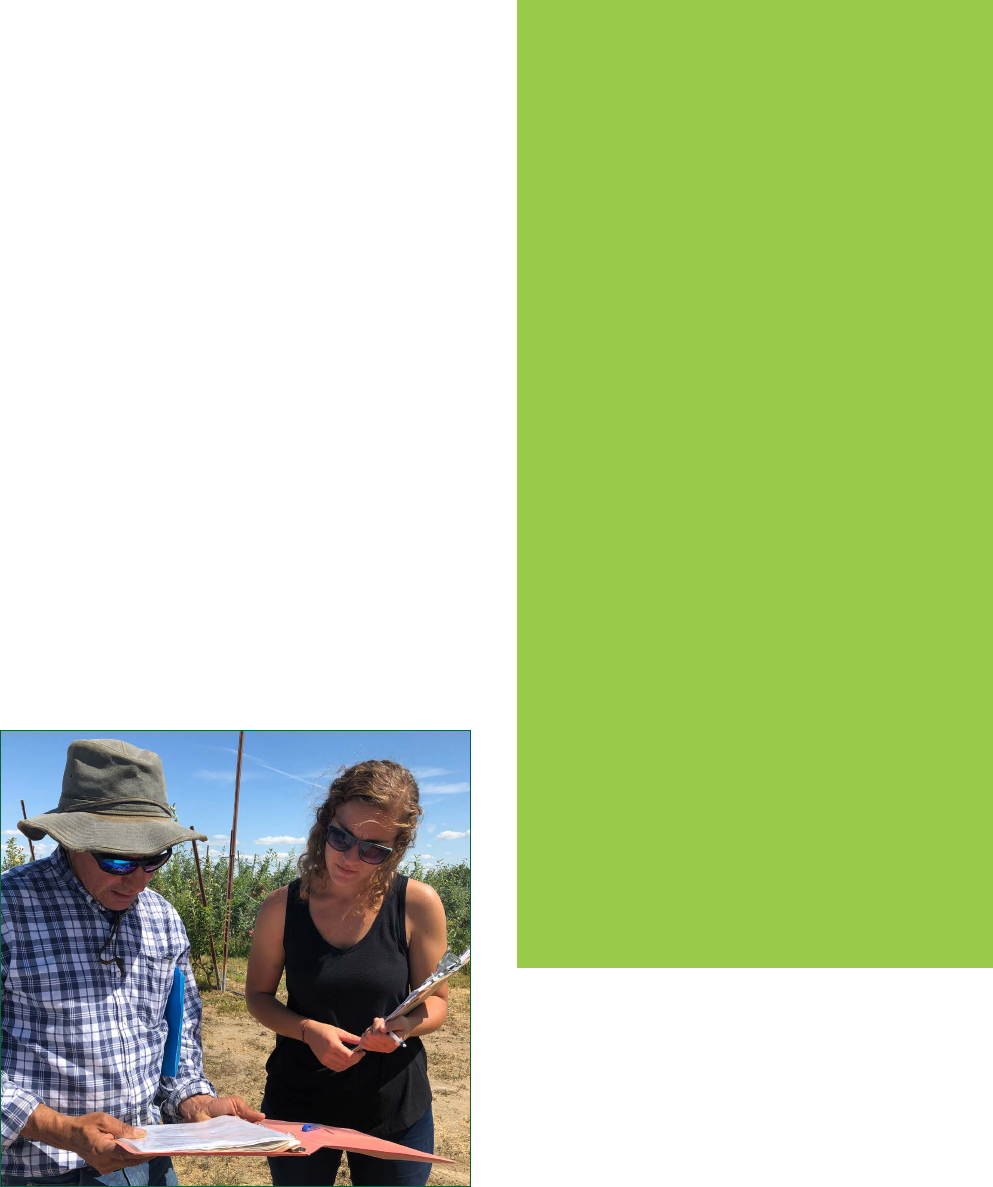
Consumer Protection
The Washington Consumer Protection Act (CPA),
Revised Code of Washington (RCW) 19.86, broadly
prohibits unfair or deceptive acts or practices in trade
or commerce (RCW 19.86.020). The CPA applies to
producers and sellers who sell agricultural and other
products at farmers markets. Under the CPA, sellers
cannot misrepresent the prices, quality, certification,
origin, growing methods, or other attributes of their
products on signage or other marketing. Basically,
Washington law requires truthful and non-misleading
signage and marketing of all products.
In addition, there are laws specific to agriculture. One
is the use of the term “Washington Grown” (RCW
15.04.410). To mislead or imply something was
grown in Washington that was not is a violation of
this law and “is an unfair or deceptive act in trade
or commerce and an unfair method of competition”
(RCW 15.04.410). Penalties may run thousands
of dollars, though the immediate consequence is
losing the opportunity to sell at farmers markets and
severe damage to a vendor’s reputation and brand. At
most farmers markets there is a presumption that all
products are grown in Washington. The Washington
State Farmers Market Association’s “Roots Guidelines”
do allow farmers markets in border counties in
Washington to have vendors from counties along the
Oregon and Idaho borders. In these cases, vendors
need to clearly indicate in their booth banner and
other signage that they are from Oregon or Idaho.
RCWs > Title 15 > Chapter 15.04 >
Section 15.04.410
Declarations of
“Washington state grown”—Restrictions
Violations unlawful—Application of
consumer protection act
(1) Before being offered for retail sale in this
state, any agricultural commodity, defined under
RCW 15.66.010, that was grown or raised in
this state may be advertised, labeled, described,
sold, marked, or otherwise held out, with the
words “Washington state grown,” or other similar
language indicating that the product is from
Washington state grown or raised agricultural
commodities.
(2) An agricultural commodity that was not
grown or raised in this state and packages of
that product shall not be advertised, labeled,
described, sold, marked, or otherwise held out
as “Washington state grown,” or in any way as
to imply that such product is a Washington state
grown or raised agricultural commodity.
(3) It is unlawful for any person to violate this
section.
(4) The legislature finds that the practices
covered by this section are matters vitally
affecting the public interest for the purpose of
applying the consumer protection act, chapter
19.86 RCW. Violations of this section are not
reasonable in relation to the development and
preservation of business. A violation of this
section is an unfair or deceptive act in trade or
commerce and an unfair method of competition
for the purpose of applying the consumer
protection act, chapter 19.86 RCW.
Farmers and farmers market organizers work together to
ensure that all requirements are clear and vendors are
in compliance so that consumers have full confidence in
every purchase.
3
—
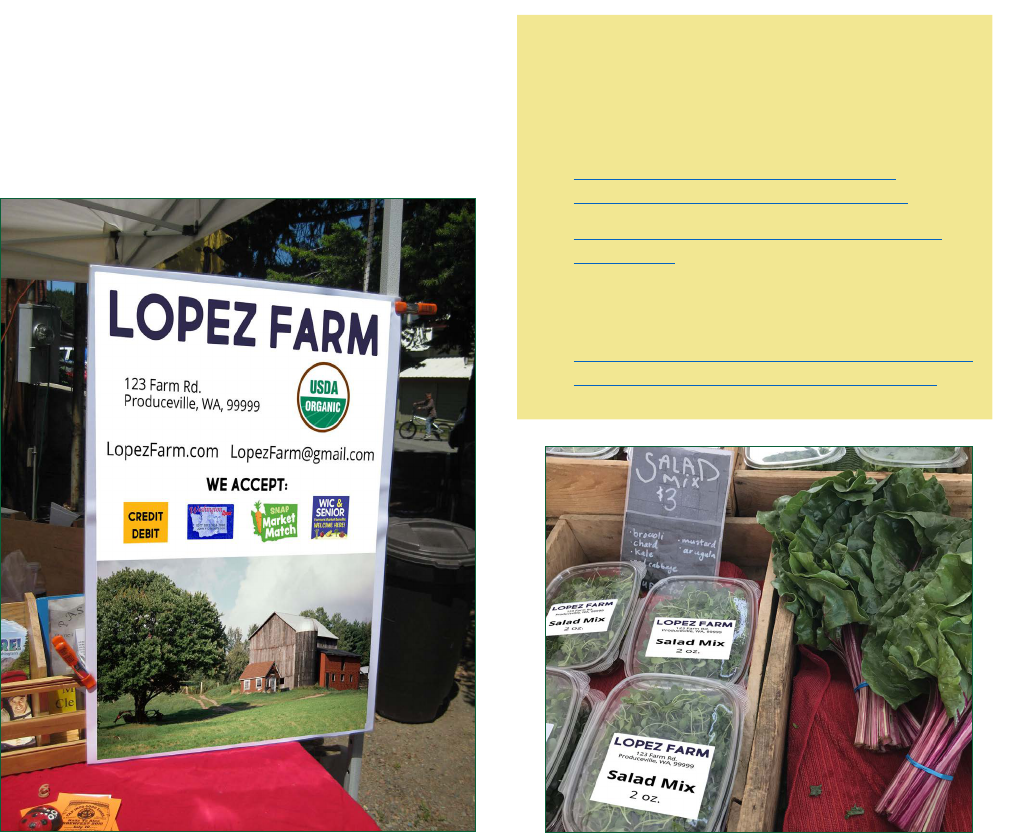
The Food Safety Modernization Act (FSMA) was signed
into law in 2011 and takes a preventive approach
to food safety. The law has specific provisions for
direct marketing. The idea is that when consumers
purchase directly from a farm they should be able to
easily identify where their food was produced. FSMA
labeling requirements help reinforce transparency and
enhance product tracing should a food safety concern
arise. As such, specialty crop farm vendors are
required to: “prominently and conspicuously display,
at the point of purchase, the name and complete
business address of the farm where the produce was
grown.” (FSMA Produce Safety Rule § 112.6)
What does this mean in practice? The first requirement
to prominently and conspicuously display should
follow common sense. A shopper should not have
to hunt for this signage. Point of purchase means
at the vendor booth where shoppers select and pay
for products. The complete business address of the
farm must include the street address (or P.O. Box),
city, state, and ZIP code.
Food Safety Modernization Act and Direct Marketing Signage Requirement
This information may be displayed in different ways:
• on business cards that are available at the
point of sale
• printed on bags or packaging
• on business signs, banners or brochures;
or on paper receipts.
Under the FSMA Produce Safety Rule, a farm may
qualify for an exemption if the farm business grosses
less than $500,000 in food sales annually and
sells primarily through farmers markets or other
direct marketing channels. However, even if a farm
is exempt, it is still required to clearly identify the
business name and address at the point of sale.
More Information on
Small Farm Exemptions
Washington State Department of Agriculture
(WSDA) website:
• agr.wa.gov/departments/food-safety/
produce-safety/small-farm-exemptions
• agr.wa.gov/departments/food-safety/food-
safety/fsma
Food and Drug Administration (FDA) Produce
Safety Rule section of the FAQs:
• www.fda.gov/food/food-safety-modernization-
act-fsma/frequently-asked-questions-fsma
Adding the farm address to a “vendor profile” that
attaches to the booth pole is an easy way to comply
with FSMA requirements.
FSMA requires the farm name and complete business
address to be displayed prominently on the food
packaging label for all “covered produce.”
4
—
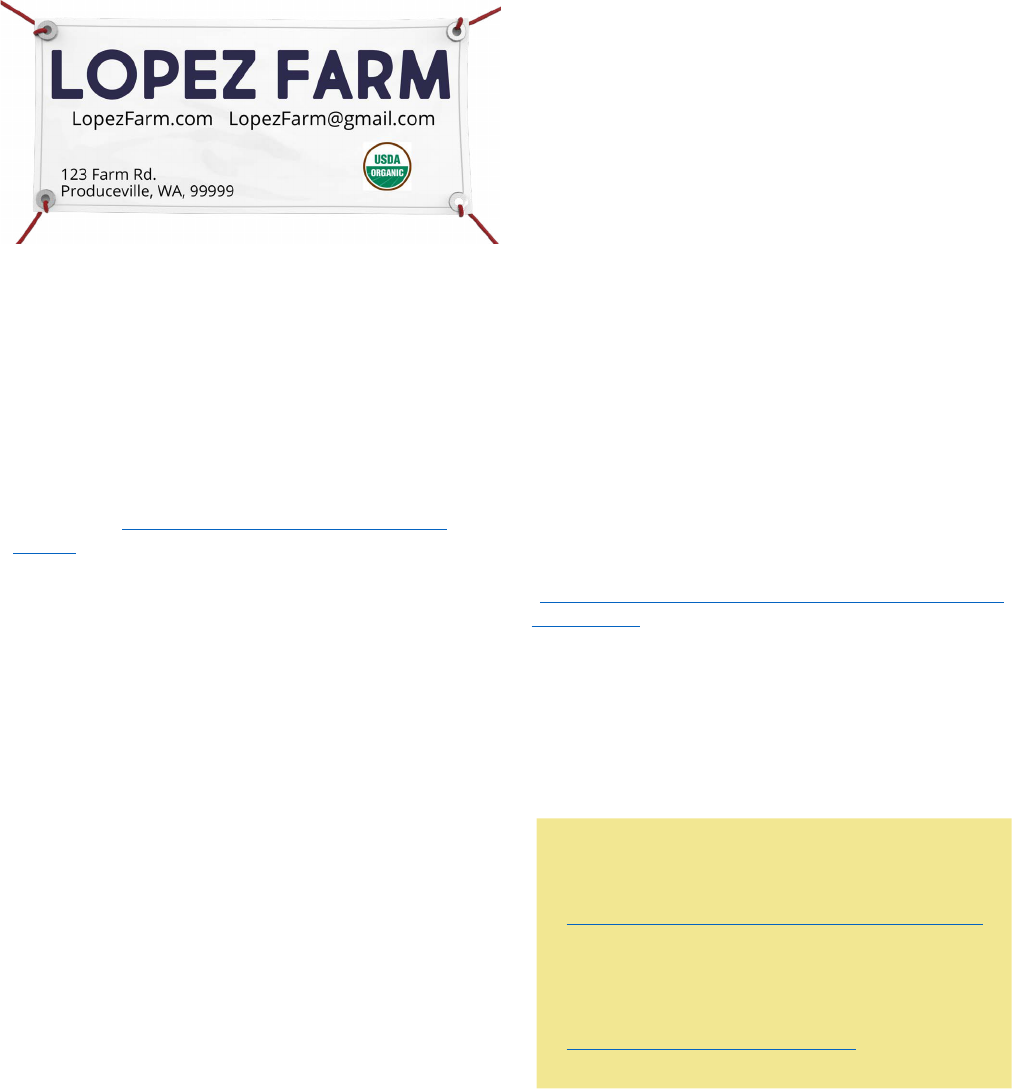
Marketing Orders and Agreements
Certain crops may be regulated by marketing orders
or marketing agreements if a particular industry,
often in a specific geographic region, has agreed on
and formalized marketing standards with the USDA.
Self-funded by the industry, marketing orders typically
authorize quality regulations, research and promotion
programs, as well as marketing, pack, and container
regulations (www.ams.usda.gov/rules-regulations/
moa/fv).
Washington State specialty crops with USDA marketing
orders that are also direct marketed at farmers
markets include apricots, sweet cherries, tart cherries,
cranberries, hazelnuts, Walla Walla onions, pears,
and potatoes. In Washington, the apple industry
has its own internal standards but does not partner
with USDA on a marketing order. In some cases, a
marketing order only pertains to a part of the state.
For example, apricots and sweet cherries have
designated their production area as “counties of
Okanogan, Chelan, Kittitas, Yakima, and Klickitat in the
State of Washington and all counties in Washington
lying east thereof.” Therefore, crops such as apricots
and sweet cherries grown in Western Washington do
not fall under these marketing orders.
In most cases, there is a de minimis clause in the
marketing order that allows producers to direct market
crops that they have grown. Crops are not required
to be inspected by the WSDA Fruit and Vegetable
Inspection program if:
1. they are sold by the producer/grower to the end
consumers for home use at farmers markets (or
other “fruit and vegetable stands” as defined by
WAC Chapter 16-461);
2. no more than a set number of pounds (net
weight) per day is sold to any one individual (end
consumer); and
3. containers (e.g., 20 pound boxes) are marked
“not for resale” in letters at least ½ inch high.
The maximum sales allowed from any one farm
vendor to any one end consumer per day is 100
pounds for sweet cherries, 220 pounds for pears, and
500 pounds for apricots.
In some cases, a marketing order or agreement may
define and limit the use of a brand name. Marketing
Order 956 defines Walla Walla Sweet Onions as “all
varieties of Allium cepa grown within the production
area, except Spanish hybrid varieties.” The production
area is defined as specific areas within Walla Walla
County, Washington and Umatilla County, Oregon
(www.ams.usda.gov/rules-regulations/moa/956-walla-
walla-onions).
Washington State has 21 agricultural commodity
commissions that are engaged primarily in marketing
and/or research related to a specific commodity. They
are funded by producer assessments and vary in size
and activity.
A list of Washington Agricultural Commodity
Commissions on the WSDA website:
agr.wa.gov/washington-agriculture/commissions
Specific information on Washington State
commissions may be found in the Washington
Administrative Code (WAC)
apps.leg.wa.gov/wac/default.aspx
The farm may use a physical address or a PO Box
as long as it is the primary business address for the
farm where the produce was grown. Adding this to a
market banner is an easy way to comply with FSMA.
5
—

Specialty crop farmers may make a variety of
production claims and display different certification
labels at farmers markets. The signage ranges
from internationally known logos to signs that are
handmade and personal. Shoppers tend to be
motivated to buy products from farmers that align
with their values and needs. Signage is a key tool to
communicate core aspirations and practices that can
help make sales, including:
• Protecting personal health by avoiding allergens
or pesticides
• Enhancing health with extra nutrition
• Protecting the environment
• Avoiding toxins and genetically modified
organisms (GMOs)
• Enhancing biodiversity, soil, water, and open space
• Enhancing animal welfare
• Promoting fair conditions for farmers and
farm workers
• Adhering to generally understood concepts
of sustainability
Marketers know the importance of communicating
product and producer attributes and there are now
over a hundred food labels and certifications. This
is confusing to many shoppers and farmers market
managers who struggle to determine what labels
mean and what to believe. Two good resources
working to explain the differences are:
• “Food Labels Exposed: A definitive guide to
common food label terms and claims” available
from A Greener World at https://agreenerworld.
org/resources/food-labels
• Consumer Reports’ “Guide to Food Labels”
available at https://www.consumerreports.org/
food-labels/seals-and-claims
A farmers market organization can proactively
determine guidelines for what kinds of signage
about product claims it will allow vendors to display
or verbally claim. The market may choose to allow
specific certifications by name or choose by general
criteria such as if a claim is third- party inspected
or self-reported. Third-party certification means
that an independent organization has reviewed
the manufacturing process of a product and has
independently determined that the final product
complies with specific standards for safety, quality or
performance. By setting product claim guidelines and
explaining the rationale behind that decision in market
policies or rules, verification of vendor signage is
clearer and more consistent for everyone.
Organic Certification and Labeling
For a variety of reasons, many shoppers seek out
organic products. Organic is perhaps the best known,
oldest, and most established third-party certification
for farmers and processors. It can, however, be
misunderstood and misused at farmers markets. Given
that organic is a federally regulated claim, knowing the
requirements for organic production and certification
is important. Vendors that misuse the term organic
potentially mislead shoppers and create tension with
those who are following certification requirements.
Here’s a rundown of how organic is defined and how
organic certification works.
The term organic refers to an entire production
system that is managed in accordance with the USDA
organic regulations. It is designed to respond to site-
specific conditions of farms and processing facilities.
An organic system integrates cultural, biological, and
mechanical practices that foster cycling of resources,
promote ecological balance, and conserve biodiversity.
In order to make organic claims, producers and
processors must certify their products through
a USDA-accredited certification agency. Some
exemptions to certification exist and are detailed
below. Organic certification evaluates whether the
business’s practices are compliant with USDA organic
regulations. The certification process verifies that
no prohibited materials (e.g., synthetic fertilizers or
herbicides) have been applied for 3 years prior to
when a crop is harvested. The National List of Allowed
and Prohibited Substances details materials for use
in organic production and processing (www.ams.
usda.gov/rules-regulations/national-list-allowed-and-
prohibited-substances).
ORGANIC CERTIFICATION & CLAIMS
Farmers market shoppers have a variety of motives for
seeking out certified organic produce at farmers markets.
6
—

In Washington State, most organic businesses are
certified by WSDA Organic Program; other certifiers
such as Oregon Tilth Certified Organic, Quality
Assurance International (QAI) and California Certified
Organic Farmers (CCOF) also certify businesses in
Washington. Regardless of the certifier, everyone is
held to the same, federally regulated standards. An
overview of the organic standards may be found
at: www.ams.usda.gov/grades-standards/organic-
standards.
The cost of certification varies and depends on the
size and complexity of the farm or processing facility,
as well as the organic certification agency chosen.
To see an example of specific costs, visit the WSDA
Organic Program webpage for the “Information for
New Applicants” FAQ (agr.wa.gov/departments/
organic/new-applicant-info).
To help offset the cost of certification, the USDA
Organic Certification Cost Share Program is available
to businesses for a portion of their certification costs.
In practice, what it means to be a certified organic
farm is far more than not using synthetic chemicals.
Farmers are required to:
• source seeds and planting stock from certified
organic sources (provided they are available)
• continuously improve soil quality through practices
like crop rotation and fertility management
• promote biodiversity and natural resource
conservation
• use approved physical or mechanical practices
to prevent pests, weeds, and diseases, before
applying approved materials
• use materials that minimize negative impact to
wildlife and the environment.
Federal law requires that any agricultural product
represented as organic, whether certified or exempt,
must be produced in accordance with USDA organic
regulations. Businesses that willfully violate USDA
organic regulations, or represent non-exempt products
as organic without certification, may be subject to
substantial civil penalties (fines) and/or have their
organic certification suspended or revoked.
In addition, Washington law specifically prohibits the
sale, or offer for sale, of a product that is represented
as organic if the producer or handler knows, or
has reason to know, that the product has not been
produced in accordance with the standards for organic
products under Washington law (RCW 15.36.030).
Some farmers market vendors claim to be exempt
from organic certification. A business is considered
exempt from certification if it meets all of the
following criteria:
1. Makes less than $5,000 in gross annual
income from all organic crops and products
(at all farmers markets and other sales outlets
combined)
2. Complies with all organic production and
handling requirements
3. Maintains records for at least 3 years to verify
compliance
4. Does not display USDA Organic seal or other
references to certification
1. First, the applicant must develop an
organic system plan and submit an
application to a certification agency such
as WSDA Organic Program.
2. Next, the certifier reviews the full plan
and application and requests additional
information if needed.
3. Once reviewed, an inspector conducts
an inspection of the applicant’s farm or
processing facility.
4. The inspector then writes a report and
submits it to WSDA Organic Program
review staff, who review the inspection
report and make a determination or
collect more information.
5. When the review is complete and
the applicant is determined to be in
compliance with organic standards,
the certifying agency issues an organic
certificate.
Organic certification is an annual process
and involves five basic steps
7
—
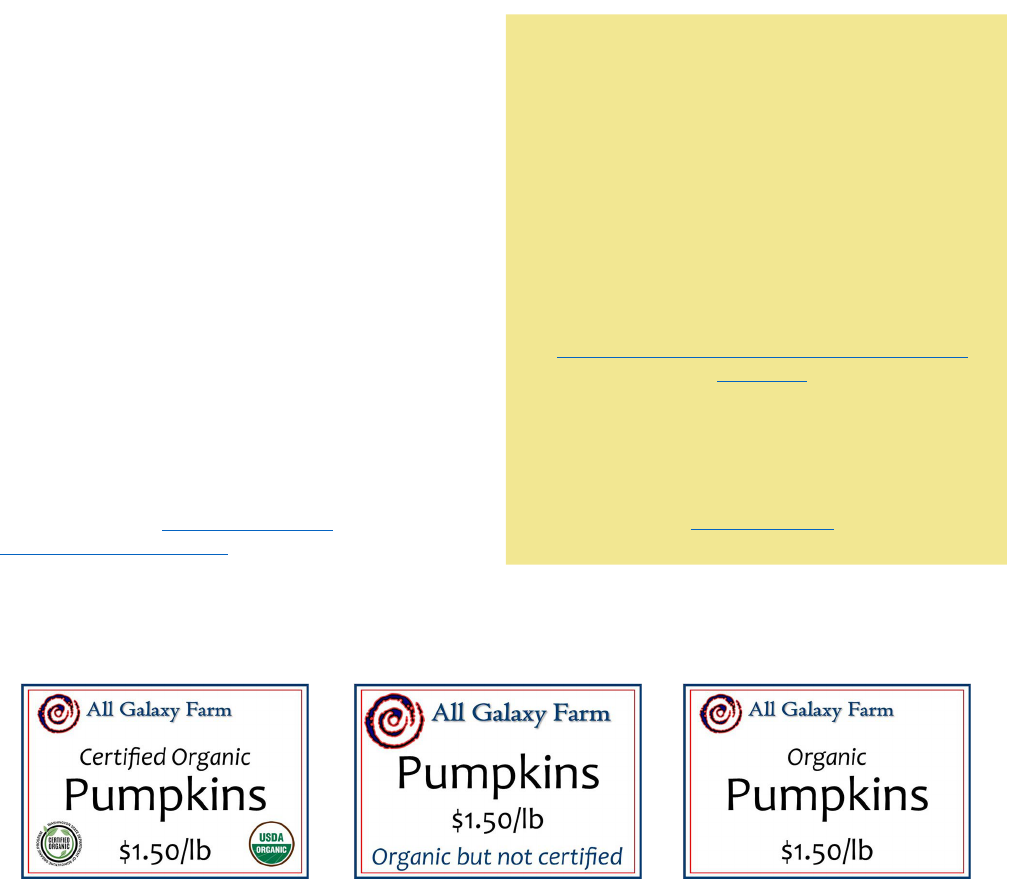
Additionally, certain businesses are allowed to make
organic claims on processed products if they are using
certified organic ingredients. This includes:
1. Processors that limit organic claims on products
to the ingredient declaration only. This means
that an ingredient is listed as organic on the
ingredient list, but the principal display panel
does not make organic claims.
2. Retailers, including farmers market vendors, that
only handle or process the final product they are
selling at the actual retail location, e.g., blending
smoothies or brewing coffee at the market.
3. Handlers that store, sell or distribute organic
products to retailers or wholesalers (not end
consumers) if these products remain in the same
package and have the same label throughout the
time the products are in their control.
For more information about the organic certification
process, contact WSDA Organic Program:
360-902-1805 or [email protected] or visit
https://agr.wa.gov/organic
What does Regenerative Agriculture mean?
The term regenerative agriculture has emerged
in recent years and is often used alongside or in
place of organic. Regenerative describes farming
and grazing practices that, among other benefits,
reverse climate change by rebuilding soil organic
matter and restoring degraded soil biodiversity,
resulting in both carbon drawdown and improving
the water cycle. Regenerative agriculture improves
soil health, primarily through practices that increase
soil organic matter.
regenerationinternational.org/why-regenerative-
agriculture
While there is no certification for regenerative
alone, a “Regenerative Organic Certified”
certification is offered by the 501(c)3 nonprofit
Regenerative Organic Alliance.
regenorganic.org
Examples of appropriate signage for certified organic and exempt products at a farmers market.
8
—

Role of Farmers Market Managers in Organic Integrity
Farmers market managers, board members, and vendors play key roles in creating a culture of integrity at farmers
markets. Not only does a culture of integrity protect farmers markets’ reputation as a trusted source of local foods,
it also helps prevent conflicts and misunderstandings. Farmers markets can take key steps before the season
starts, during the market season, and after the season ends to ensure the integrity of organic claims are upheld.
BEFORE THE SEASON STARTS
q Include questions and criteria in the farmers
market application about any product claims
and certification a farmer may plan to use at the
farmers market.
q Make a note if the vendor plans to sell certified or
exempt organic products.
q Note if the vendor is a split operation with both
organic and non-organic products. This is fairly
common, and requires extra care to keep the
organic and non-organic products separated.
q Note if the word organic is included in the
business name.
q Ask if the word organic is printed on banners,
bags, or other signage.
q Note if the vendor is newly certified organic,
maintaining their certification, or has dropped
their certification.
q Ask what other claims the business plans to make
at your or any farmers market this season.
q Ask for a copy of the vendor’s organic certificate.
q Verify organic certification with a desk audit. All
certified organic businesses are listed on the
USDA’s Organic Integrity Database: organic.ams.
usda.gov/integrity Note: The database is not
always updated in real-time. If you don’t find the
business, the next step is to ask the vendor or
their certifier for confirmation.
q Note if a vendor claims an organic exemption due
to their organic income. Exempt organic claims
are for businesses that make less than $5,000
annually in total organic sales.
q Establish a complaint process for vendors or
shoppers if they are contesting the use of the
organic logo or any other production claim being
made at the market.
DURING THE SEASON
q Consider implementing a monitoring program
to review vendor booths and document claims
made, signage used, and logos displayed.
q Compare what products and signage vendors
have in their booths with what they wrote in their
application. When in doubt, ask questions to learn
more about the process and collect evidence prior
to reaching any conclusions.
q Review organic certificates and ask questions if
something is unclear or appears inconsistent.
q Consider educating shoppers about certified
organic products and producers through social
media, events, and featuring farms.
q Report violations if a vendor is intentionally
making fraudulent claims. To report a WSDA-
certified organic business, contact the Organic
Program directly: agr.wa.gov/departments/
organic/contact-us
q For non-certified businesses, contact USDA
National Organic Program: www.ams.usda.gov/
services/enforcement/organic/file-complaint
AFTER THE SEASON
q Reflect on the season and identify any questions
you have and want to learn more about. Attend
workshops or other trainings offered by WSDA or
WSFMA.
q Do fact finding on any controversial claims or
disputes.
q Review farmers market application and vendor
review process.
9
—
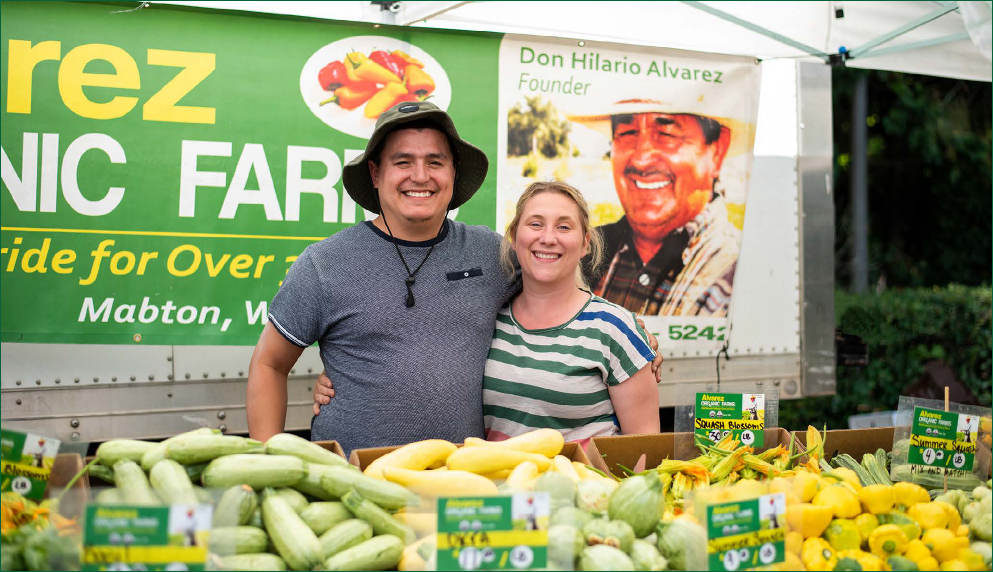
Role of Certified Organic Farmers
Certified organic farmers also play an important role in fostering a culture of integrity at farmers markets. Market
managers are eager to learn about agriculture but may need more information to be able to ask the right question
or understand an explanation. Farmers can share what it takes to be certified organic and why it is important. This
helps farmers markets better represent organic farming to shoppers, to the media, and in other promotions.
BEFORE THE SEASON STARTS
q Apply for/renew organic certification.
q Provide accurate and up-to-date information in
farmers market applications about any organic
claims or certifications you plan to use.
q Update any signage that will be used in the
market booth.
q Train any employees who will be selling directly
to customers at farmers markets or farm stands.
Make sure they know what being “certified
organic” means and what claims they are allowed
to make.
DURING THE SEASON
q Maintain organic practices and certification.
q Use appropriate signage and wording at the
market booth.
q Train all employees about your organic
certification so they can correctly represent you
and your products to shoppers.
q Report any concerns to the farmers market
manager.
AFTER THE SEASON
q Update market managers of any changes to your
organic certification.
Organic certification is nationally recognized and offers third party verification of production claims. It can become
part of the farm story and help vendors to stand out at the farmers market.
10
—

Organic Signage and Product Labeling at Farmers Markets
If organic products and producers are certified, they may use the phrase “certified organic” and the USDA organic
seal in their signage. There is some confusion when it comes to exempt organic producers at farmers markets.
A business may say that its farm or products are organic. However, exempt organic businesses cannot use the
term “certified organic” and they cannot use the USDA organic seal or certifier logos.
CRITERIA
Gross sales of organic products
per year from all market outlets.
Business has a current organic
certificate issued by a USDA-
accredited certifier (e.g., WSDA
Organic Program or Oregon
Tilth).
Business, crops, and products
are listed in the USDA Organic
Integrity Database.
Can use the term organic or
certified organic.
Use of the USDA seal or
certifier logo.
The term organic may be used in
the business name. If a banner
with the business name is
displayed at the farmers market,
then all products must be
produced organically.
CERTIFIED ORGANIC
Can have any amount of sales.
There is no minimum and
no maximum.
Yes
Yes
Yes
Using term certified is optional
Yes
Yes
EXEMPT ORGANIC
Required to have less than $5,000
in annual gross organic sales.
No
No
Can only use term organic.
Cannot use term certified.
No
Yes
Farmers market vendors who sell organic processed
products may have additional packaging requirements
that are not covered in this guide. See WSDA Organic
Program’s Organic Label Requirements page for
more information: agr.wa.gov/departments/organic/
resources/organic-labels
In some cases, a farmers market vendor has a split
operation, meaning some crops or value-added
products are organic and some are conventional.
This could be a farm using organic and non-organic
practices on separate sites, or farms supplementing
their produce with non-organic products. Split
operations must pay extra attention to keep organic
and non-organic products segregated to prevent direct
contact, contamination, and confusion about which
products are organic. This includes segregating organic
and non-organic throughout production, packing,
transportation, and display at the market.
The challenge at a farmers market is that shoppers
who see some organic products at a booth may
reasonably assume that all products sold are organic.
Therefore, it is strongly recommended that the
farmers market require all non-organic crops sold in
booths with organic products to be clearly labeled as
“conventional” or non-organic.
There is high potential for confusion and
misrepresentation if a farm name or banner includes
the term organic. The term organic may only be used
in a farm name provided the farm’s total gross annual
income is less than $5,000 annually. If displayed
above crops, all of those crops must be produced
organically.
11
—

Problematic Claims and Signage
In addition to organic and other certifications or logos, informal, vague and unverified claims are sometimes
used by specialty crop vendors. These include claims like “No Sprays,” “No Pesticides,” and “No Chemicals” that
appear on price or product signage and sometimes on banners. Each of these claims is highly problematic and it
is strongly recommended they not be allowed at farmers markets. Such terms are not regulated by peer-review,
independent, or third-party inspection, nor do they have standard definitions. Even if genuine and well-intended,
such terms are subjective. At their worst, they are an attempt to evoke organic or to suggest more sustainable,
natural growing practices without being verified. Because these claims have potential for misuse, are misleading
to shoppers, and often frustrate other vendors, farmers markets should have clear, written, and board-approved
policies about whether or not such signage is allowed and why—or why not. Only allowing product claims with
clearly defined terms, or claims verified by third-party certifications, is strongly recommended.
SIGN
No Sprays
No Pesticides
Pesticide Free
No Chemicals
PROBLEMS
• Highly misleading
• Spray is simply a method of delivery
• Implies that crops were not sprayed with toxic substances and shoppers will infer
this without any additional information
The No Sprays claim is especially misleading with Washington tree fruit. Commercial
orchards in the state use sprays, organically approved or otherwise, to control pests
and diseases that may otherwise threaten the tree fruit industry. If there is tree fruit
in a farmers market with a No Sprays sign and it is beautiful with no pest or disease
damage, it is likely a fraudulent sign.
• High potential to be misleading
• Suggests no pesticides used throughout the entire growing process from
seed to harvest
• Implies there were also no herbicides or fungicides used in production, harvest
or post-harvest
• Shoppers and novice farmers conflate “no pesticides” with organic production,
which is inaccurate. Organic production allows for pre-approved pesticides that
meet specific criteria.
• Highly misleading
• Everything is composed of chemicals; even natural substances are chemical
• Implies crops were produced with no petroleum-based agrochemicals or
synthetic fertilizers
Enforcing restrictions on problematic claims and signage may be a challenge, especially when vendors have used
them for years. Plan any change in policy with thoughtful timing and ample communication. Misrepresenting
products and inaccurate signage can severely affect shoppers’ well-being as well as their trust. For shoppers with
underlying health issues, this ambiguity and deception can have serious consequences.
12
—
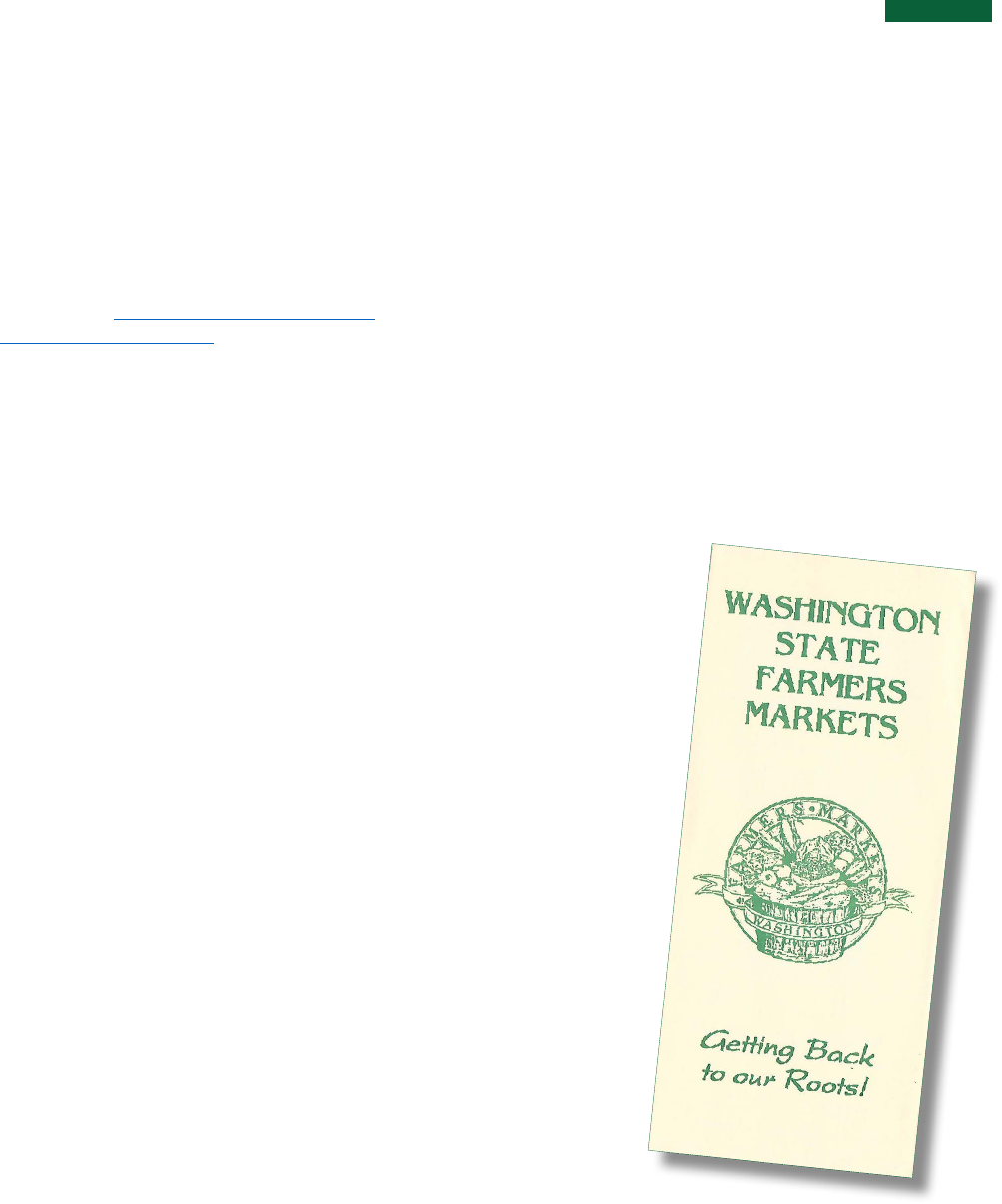
In addition to legal or regulatory requirements for
signage or use of specific production claims, signage
standards are set by the WSFMA’s “Roots Guidelines,”
and different payment and food access programs.
Washington State Farmers Market
Association “Roots Guidelines”
Farmers markets that are members of the
Washington State Farmers Market Association
(WSFMA) are expected to abide by the “Roots
Guidelines” (wafarmersmarkets.org/wsfma-
rootsmemberguidelines/). In 1995, the WSFMA Board
of Directors recommitted itself to an agriculturally-
based market system and implemented minimum
qualifications for membership and insurance coverage
modeled after the California farmers market law.
The WSFMA’s “Roots Guidelines” ensure three core
principles:
1. Farmers markets are where a grower sells directly
to the consumer.
2. Farmers markets offer small farmers the best
opportunity to profit from their land and efforts.
3. Farmers markets are a marketplace where
consumers can talk directly to the grower,
purchase the freshest produce possible, and
experience the health-giving effects of that
freshness.
Understanding that some farmers markets need to
find ways to complete their product and vendor mix,
the “Roots Guidelines” do allow resellers if they meet
certain criteria. Whether or not a farmers market
allows vendors to resell products should be clearly
documented in the market policies and rules.
In order to allow a reseller at a WSFMA farmers
market, the vendor must meet all criteria. This
includes that a reseller is “the only stop between the
grower and the consumer.” Products being resold
“must not come from shippers, warehouses, jobbers,
or wholesale distributors.” At no point should a
shopper be led to believe, through verbal or written
communication or inference, that a reseller is the
farmer who has grown or produced what is being sold
at the farmers market. This is consumer fraud and a
serious violation of trust.
SIGNAGE SPECIFIC TO WASHINGTON FARMERS MARKETS
In the interest of full transparency to ensure shoppers
clearly know where their food comes from, resellers
are required to have clear information at their booth
that declares which products are resold.
Signage must clearly state:
• Name of the farm(s) that produced each product
• That the farmers market vendor is reselling it;
other terms synonymous with “resold” may be
substituted
Cooperative farmer booths are not classified as
resellers. Cooperatives have a formal business
relationship with shared investment and risk.
Cooperative booths should use clear signage so
shoppers know which products were grown by which
members of the cooperative at any given time.
The WSFMA’s
“Roots Guidelines”
were adopted in
1995 to ensure
farmers markets
prioritize farmers
and Washington
agriculture.
13
—

RESELLER REQUIREMENTS
Excerpted from the WSFMA Roots Guidelines
wafarmersmarkets.org/wsfma-
rootsmemberguidelines
Resellers buy produce from farmers in Washington
State, or the border counties with Oregon or Idaho,
transport it to a WSFMA Member Market, and resell
it to the consumer. Resellers must meet all of the
following criteria:
1. Resellers are expected to be the only stop
between the grower and the consumer. The
product they buy must not come from shippers,
warehouses, jobbers, or wholesale distributors.
2. Resellers must not sell any produce not grown
in Washington State or the border counties.
3. Resellers may sell any produce they grow
themselves on their own property.
4. Resellers are sellers of crops that cannot be
grown reliably, or are not offered for sale
in sufficient quantity, by farmers selling at a
given WSFMA Member Farmers Market, as
determined by the individual WSFMA Member
Market’s governing body.
5. Resellers must have all crops pre-approved
by the WSFMA Member Farmers Market’s
governing body before delivering the crops to
market for sale. Approved, resold crops must
be specifically limited, so as not to compete
with the crops of Farmers within the geographic
vendor boundaries of the WSFMA Member
Market, as defined by the Market’s policies and
by-laws.
6. All resellers must label all products as
being resold if they are not selling products
which they have grown, raised, or harvested
themselves on property that they own, lease, or
rent.
7. All information declaring which products are
resold must be available and displayed for the
consumer to easily read. Signage must clearly
state which farm(s) produced the products;
other terms synonymous with “resold” may be
substituted.
8. Resellers from border counties in Oregon
and Idaho are not allowed to sell at WSFMA
Member Farmers Markets.
Payment and Food Access Signage
Farmers markets have greatly increased payment
options for shoppers. In addition to cash, farmers
markets offer tokens or scrip to be used at vendor
booths, vendors may accept credit or debit cards, and
some farmers markets have even created their own
“market bucks” to be spent at the market. Additionally,
specialized “currencies” are in use for food access
programs. These include the Women, Infants, and
Children (WIC) and Senior Farmers Market Nutrition
Program (FMNP), the Supplemental Nutrition
Assistance Program (SNAP) or Electronic Benefits
Transfer (EBT), and an increasing number of matching
programs such as SNAP Market Match. The plethora
of ways to pay have prompted many farmers markets
to create their own internal guidance to train staff and
vendors, but can be a confusing landscape for the
casual shopper.
As fewer shoppers carry cash, being able to accept the
latest payment options at farmers markets can directly
increase sales.
As with other signage strategies, signaling where
shoppers can use their credit or debit cards should be
as clear and consistent as possible. Consider adopting
a common logo that is used at other retailers, whether
from a credit card company or a processor like Square.
When determining signage for food access programs,
signage is standardized and programs come with
specific requirements.
14
—

Supplemental Nutrition Assistance Program
SNAP is the Supplemental Nutrition Assistance
Program (SNAP), the federal government’s largest
food assistance program. Considerable work has
been done over the years to ensure shoppers can
use SNAP benefits at farmers markets. Not all farmers
markets accept SNAP, but most do. In Washington
State, shoppers use a Quest EBT card created by the
Department of Social and Health Services (DSHS) to
access SNAP benefits. Most SNAP EBT programs are
managed by the farmers market and use a token or
scrip that is distributed at the information booth to
shoppers who can use it at vendor booths. Like FMNP,
SNAP can only be used to purchase federally defined
eligible foods, including fruits and vegetables, breads
and cereals, meats, fish, and poultry, dairy products,
seeds, and plants that produce food.
Unlike the FMNP program, shoppers are used to
seeing SNAP and EBT signage at other retailers.
Some farmers markets have created their own
signage around SNAP EBT. However, to present
more standardized and easily recognized signage,
the WSFMA has been working with DSHS to provide
banners and A-boards signaling to shoppers that a
farmers market accepts SNAP.
Farmers Market Nutrition Program
for Women Infants and Children (WIC) and Seniors
The Farmers Market Nutrition Program for Women
Infants and Children and Seniors is managed by the
Washington State Department of Health (DOH).
This is the only food access program designed
specifically for farmers markets and food stands. Both
farmers markets and specialty crop farmers must be
authorized to accept FMNP checks. Shoppers receive
about $20.00-$40.00 a year and can shop for eligible
foods with FMNP checks between June 1 and October
31. Eligible foods are locally grown, unprocessed,
fresh, nutritious fruits, vegetables, and cut herbs.
Seniors may also purchase honey.
To signal which vendor booths honor FMNP checks,
DOH provides signage vendors are required to post.
As part of a grower agreement, vendors agree to
display a “WIC & Senior Farmers Market Benefits
Welcome Here” sign in a place clearly visible to the
FMNP customer as required under WAC 246-780-
028(1). Failure to properly display the authorized
grower identification sign is a Class 1 violation.
(www.doh.wa.gov/Portals/1/Documents/Pubs/964-
005-WICSeniorFMNPGrowerAgreement.pdf)
HOW FMNP WORKS
• Farmers market must
be authorized by DOH.
• Vendors must be
authorized by DOH.
• Shoppers who are
eligible and sign up
receive checks directly
from local agency.
• Checks are preprinted
for a specific amount
($4.00 in 2021).
• Checks change colors every year.
• Checks for WIC and Senior are different colors.
• Shoppers can spend FMNP at farmers market or
farm stands between June 1 to October 31.
• No change given.
• Vendors stamp and deposit checks.
• FMNP signs for vendors booths are available from
DOH or market manager.
HOW SNAP WORKS AT FARMERS MARKETS
• Shoppers take EBT card to Information Booth and
get tokens or scrip that they can spend at booths
to buy eligible products.
• Vendors get reimbursed by farmers markets for
tokens accepted.
• No cash given to shoppers as change
(tokens OK).
• SNAP tokens
do not expire.
In Washington
State, SNAP benefits
are electronically
loaded on to a
“Quest” card and is
also known as EBT.”
15
—
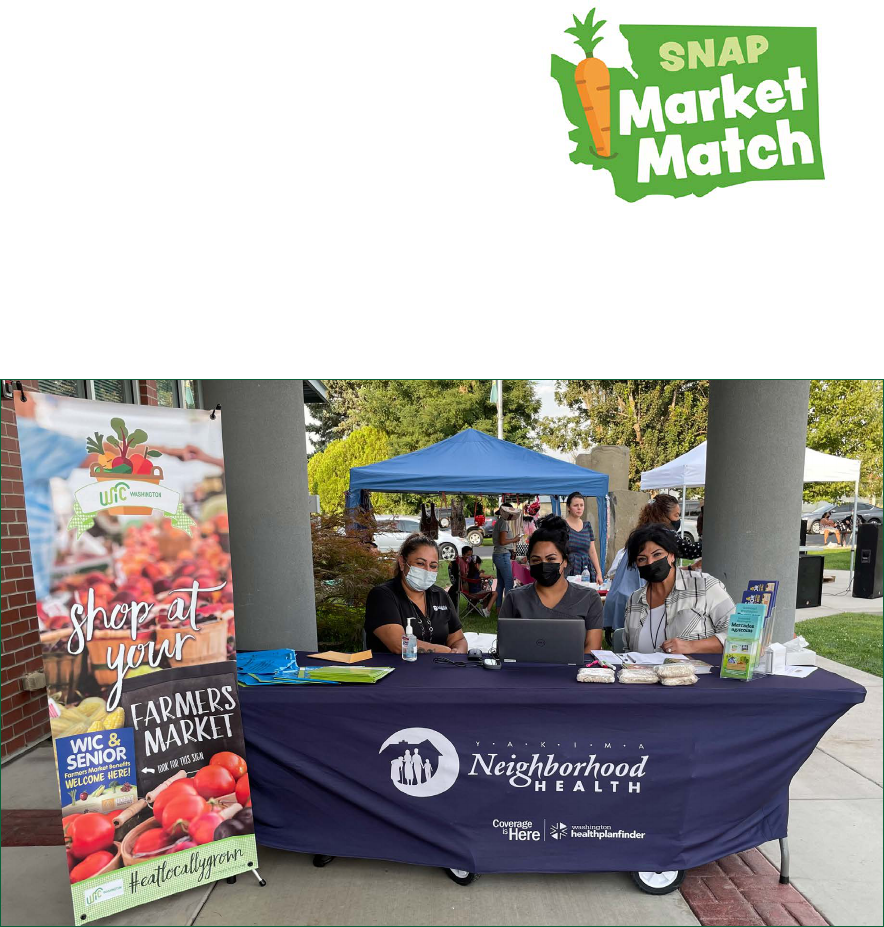
HOW SNAP MARKET MATCH WORKS
• When shoppers get their SNAP tokens from the
farmers market Information Booth, they may get
an additional “match” of $40 or more to buy fruits
and vegetables.
• SNAP Market Match can be used at any
participating farmers market.
• SNAP Market Match does not expire.
SNAP Market Match
In recent years, a new type of food access program
emerged to incentivize people with SNAP to shop at
farmers markets. Also called matching, these programs
provide additional tokens or scrip to shop at the
farmers market. Program names like Fresh Bucks,
Double Up Bucks, Double Up Food Bucks, or Healthy
Bucks were used, each with their own signage.
Typically, programs would match up to $10.00;
however, in recent years this amount has increased.
In 2020, the Washington State Department of Health
launched a statewide matching program that brought
the disparate matching programs together under one
primary name and logo: SNAP Market Match. Farmers
markets must accept SNAP EBT in order to participate
in SNAP Market Match. Like EBT, shoppers get SNAP
Market Match at a farmers market’s information booth
and can only buy eligible products including fresh
fruits, vegetables, mushrooms, herbs, seeds, and
plants that produce food.
In Seattle, farmers markets also participate in a
program run by the City of Seattle called Fresh Bucks,
which works like SNAP Market Match but can also be
used at grocery stores and farm stands.
16
—
Community partners play an important role in connecting families with SNAP and FMNP food assistance to
farmers markets. Food access programs directly support Washington farms and help all families enjoy local,
healthy fruits and vegetables.

SIGNS THAT WORK AT THE MARKET BOOTH
Farmers markets are renowned for their visual feast
– peaked vendor booths, beckoning flags, vibrant
produce displays, the hustle of shoppers, and lots
of signage. There is signage identifying the farmers
market; directing vehicle and foot traffic; A-boards with
market rules, events, and other promotions; and alerts
to possible hazards such
as electric cords. Within
each vendor booth, there
are banners identifying
the businesses, product identifiers, pricing, and
information about how products were grown or made,
including certifications and other branded labels.
Step back and ask what messages are reaching
shoppers? Are they able to see business and product
names through the colorful chaos? If not, reflect
on how to maximize the effectiveness of the visual
design and signage at farmers markets so that each
message breaks through.
Signage overload is a real challenge. Too many types
of signs are often in an endless array of materials,
styles, and conditions. How can we improve
visual communication through design and, where
appropriate, greater consistency between farmers
markets? Keeping signs clear, consistent, and simple is
an approach likely to lead to the best results.
Signage overload
is a real challenge.
It may sound obvious, but it is essential to place signs where people can actually see them without being
blocked or out of the line of sight. Signs that are viewed close up such as price signs can be smaller, while
signs viewed from further away should be larger. Be sure to take a critical look at the booth and analyze
what shoppers see. If there is no time to do so during the market, take photos and study them at home. Ask
employees to take a photo of the booth to appraise what is working and what needs fine-tuning. Make sure the
most important information can be seen from outside the booth. Finally, take care of market signs and replace
them when they look worn or dirty.
HOW TO MAKE SUCCESSFUL FARMERS MARKET SIGNS
q Make signs as legible and easy to read as possible
q Use the same colors, fonts, and materials to reinforce a brand
q Use materials that are durable, reusable, and, where possible, can be edited
q Use employee shirts, aprons, or other wearable items as “signs”
q Use brightly colored “SALE” or “SPECIAL” header cards to attract attention to a promotion
q Make sure the backs of signs are blank and clean
q Use signs to acquaint customers with new items, new varieties, or new uses
q Translate signage into languages spoken by shoppers at the market
17
—
Farmers Market Booth Signage Check List
Farmers market managers and vendors should take stock of vendors’ booths at different points in the season.
Signage is an educational opportunity to communicate a product’s name, price, origin, characteristic, seasonality,
and more.
q
Vendor name and address clearly visible; usually displayed on a banner, but could also
be on t-shirts or other signage.
• Is the vendor booth easily identified?
• How will shoppers remember it next week?
• If the booth location changes, will shoppers remember the business name or colors?
q
Prices posted for every product, at every market. Clear pricing instills shopper confidence
in being charged the correct price, furthering trust. Absence of signage increases
suspicion and likely reduces sales.
• Is it easy to see what products cost without asking?
• Is it clear how products are sold, e.g., by the bunch, pound, basket?
q
Crop or product names included on price signs or other places that are easy to spot
• Are variety names or breeds included to make products more recognizable?
• Is product separation & signage sufficient to determine differences between varieties,
e.g., hot vs. sweet peppers, tart vs. sweet apples, slicer vs. paste tomatoes?
q
Special characteristics and attributes included on product signage
• Is the method of production described, e.g., organic?
• Is product freshness indicated, e.g., picked today?
• Is the product seasonal, e.g., first or last of the season?
q
Promotions and featured products stand out
• Is there a featured or seasonal product?
• Are samples offered?
• Are there any promotions, e.g., bulk or volume sales?
• Are recipes available that offer ideas for what to do with the products?
q
Shoppers know how they can select products
• Are bags readily available and easy to spot and use?
• Do shoppers help themselves or ask for assistance?
q
Where and how to pay
• Can shoppers see where to pay at your booth?
• Do shoppers know what their payment options are?
18
—
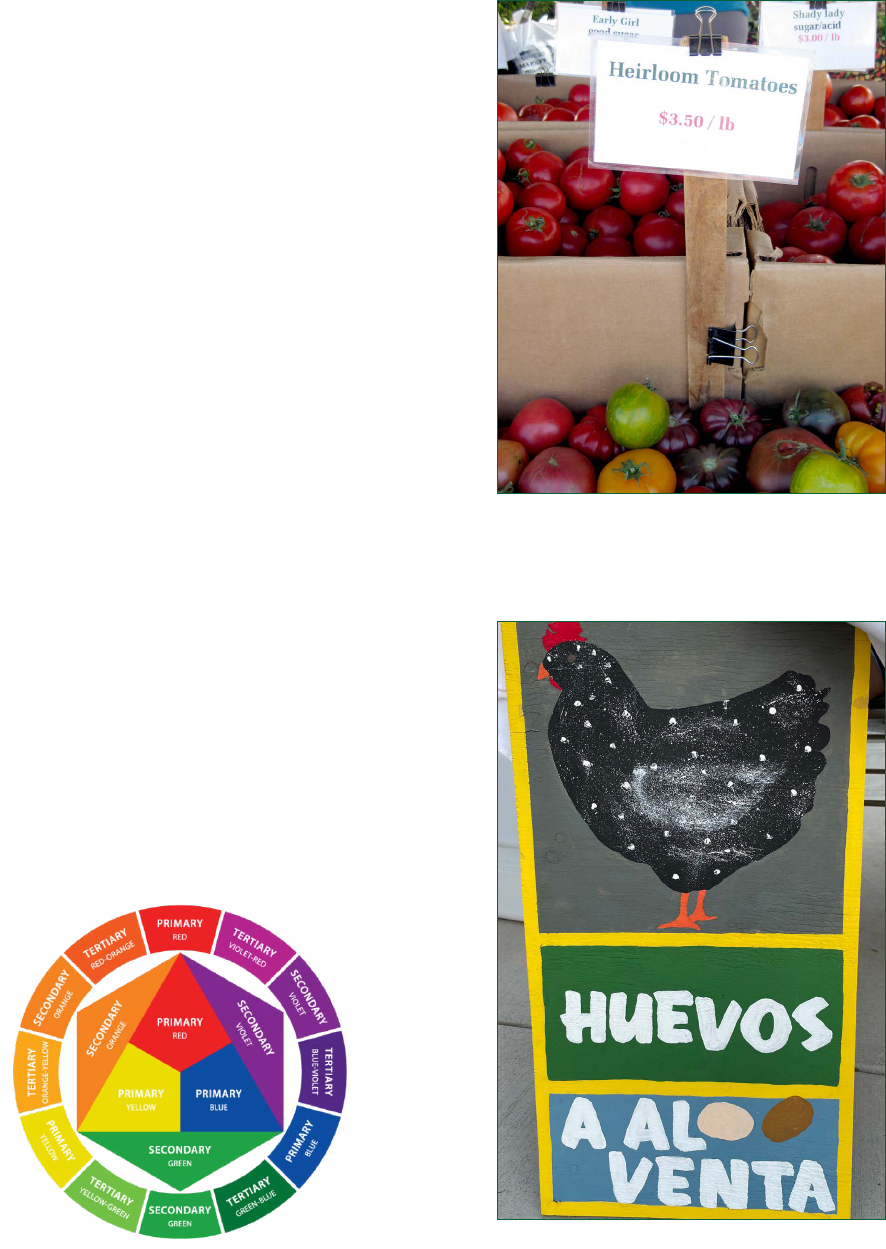
Tips for Effective Signs and Banners
Not all signs are equally effective at communicating.
Given all the hard work that goes into growing
produce and getting it to market, it is important to
put some effort into signs that lead to sales. Effective
signs aren’t complicated and following basic principles
will get the job done.
• The simpler, the better. While tempting to fill
the entire space, remember that you have mere
seconds to get someone’s attention and hit
your key message. Put only the most important
information on a banner. Do not overcrowd the
space. The fewer words on the banner, the more
likely it is shoppers will actually read it.
• Make signs easy to read. A few key features
make a banner easy or difficult to read, especially
color and lettering. Are you using contrasting
colors that can be easily read from outside of
your booth? Do the words jump out, or are they
lost in the background? Lettering can be tricky.
Use bolder and larger fonts for emphasis. Print is
easier to read than cursive. Use only one or two
fonts or styles. Simple fonts are easier to read
at a glance. Many vendors make effective use of
neat, hand-printed signs. Others may choose to
commercially print banners and signage.
• Keep signs clean. Even well-designed signs will
turn off customers if they are dirty, beat up, or
worn out. And it is easy for signs to wear out
at farmers markets! Experiment with different
materials that work for you and can look as good
in August as April. If needed, refresh signage and
banners so that every impression you make with
customers is as positive as possible.
Using a color wheel can help you choose
contrasting colors that make signs easier
to see and read.
19
—
Carefully handpainted signs look great.
Having signage in the languages your
shoppers speak helps create a welcoming
environment and increase sales.
Example of a clean price sign that clearly
identifies product, has price in contrasting color,
is laminated so that it looks better, longer, and is
well positioned so that shoppers can easily find it.
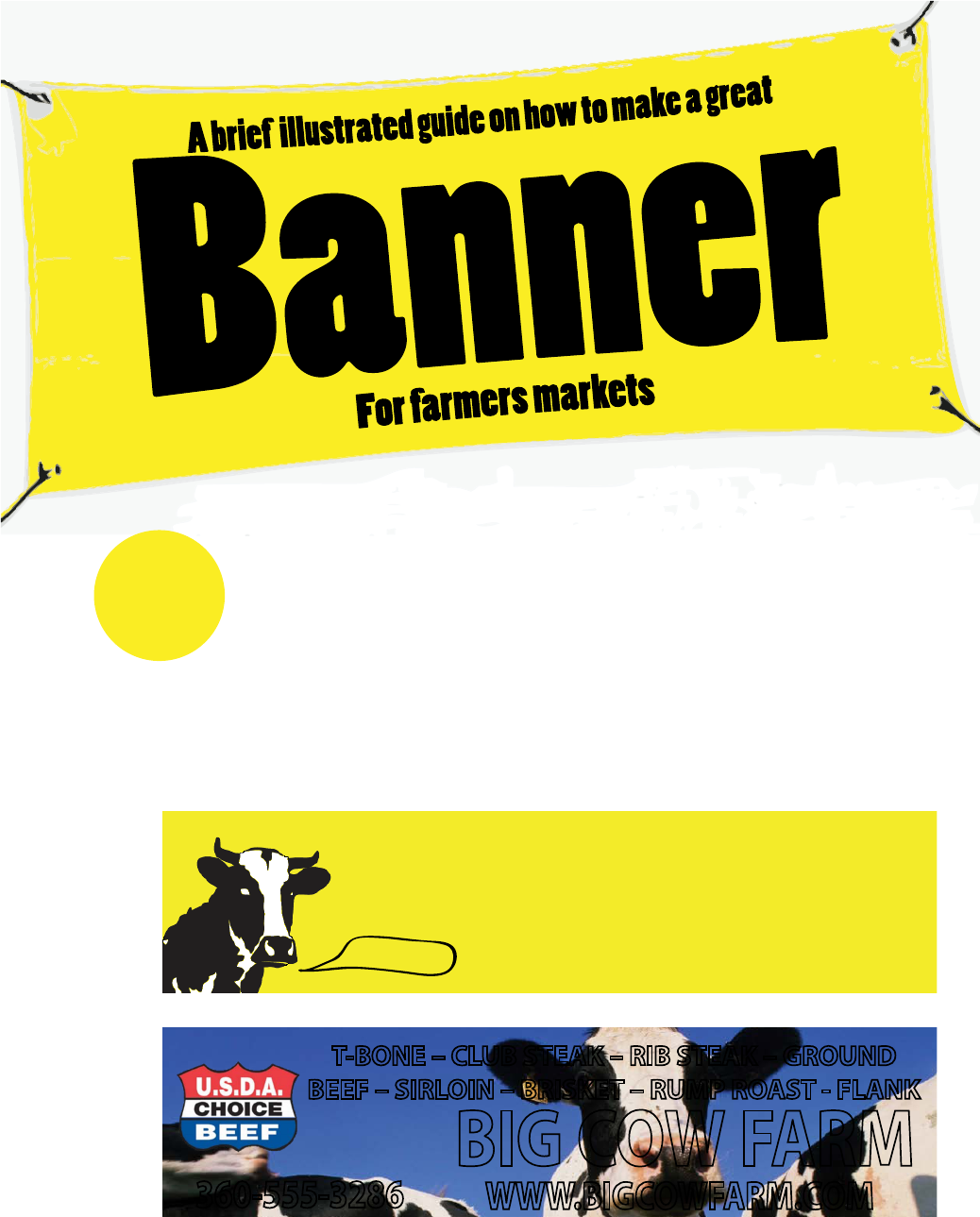
#1
The simpler, the better
Put only the most important information on your banner: the name of
your farm, name of town, or region (e.g. Sunnyside or Yakima Valley),
and your logo (if you have one). An attractive image can work if you
don’t have a logo. Do not overcrowd the space. Remember that most
people will only quickly glance at your banner. The fewer words that
are on your banner, the more likely it is that people will actually read it.
BIG COW FARM
Cowland, WA
Eat our beef!
ORGANIC GRASSFED BEEF
BIG COW FARM
T-BONE – CLUB STEAK – RIB STEAK – GROUND
BEEF – SIRLOIN – BRISKET – RUMP ROAST - FLANK
ORGANIC
GRASSFED
360-555-3286
WWW.BIGCOWFARM.COM
Yes
No
Easy to read, even
from far away
The most important
information is the
biggest
1 simple and
memorable image (a
talking cow?!)
Too much
information!
The name of the farm is
small and lost in the
other text
It is difficult to read the
text and hard to see the
image of the cow in the
background
created by: Sarita Schaer
20
—
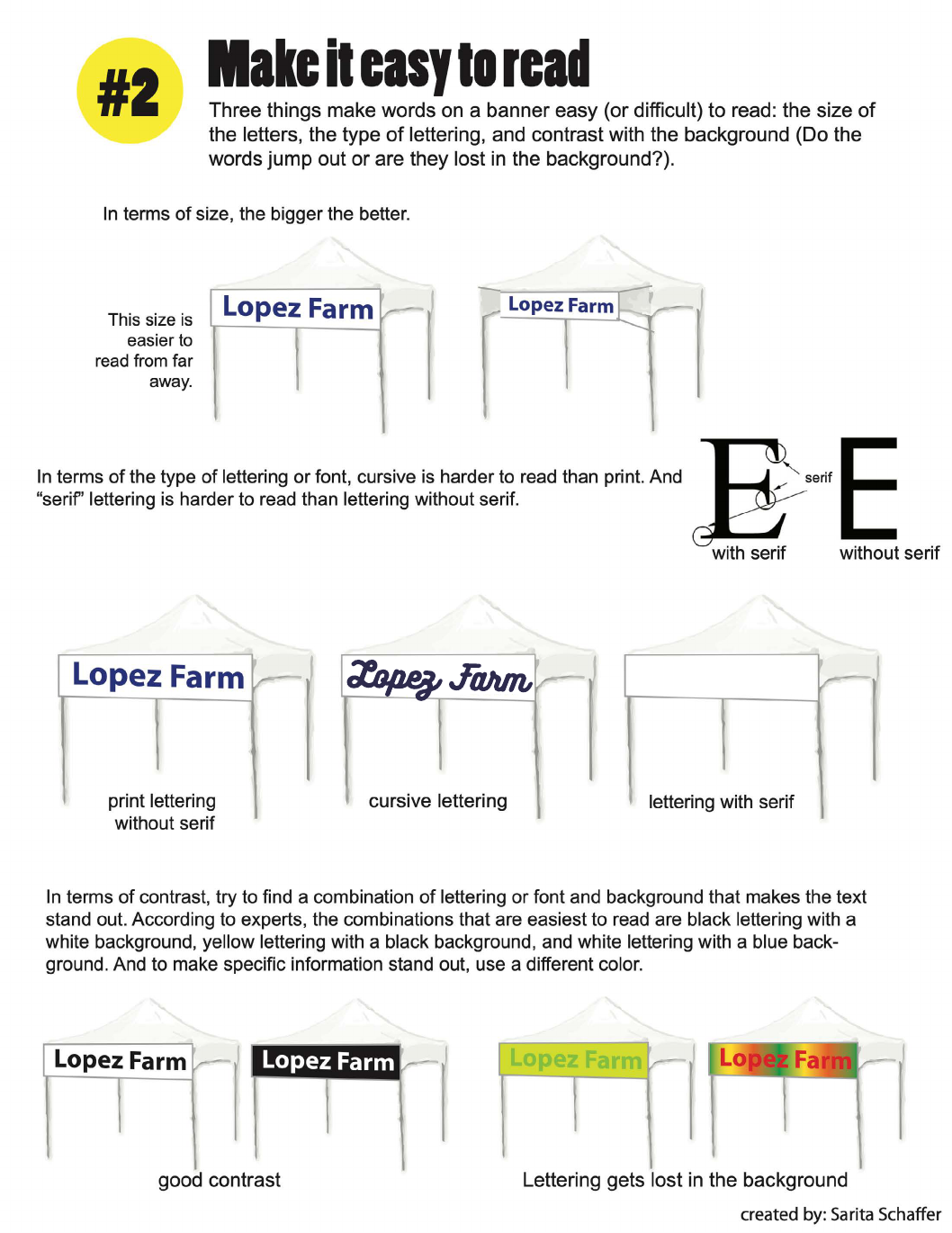
Lopez Farm
21
—
This “Guide to Fresh Produce Signage Standards and Organic Integrity at Farmers Markets” is designed to raise
awareness about the need for better signage at farmers markets. Signage is a critical communication tool between
farmers markets and vendors as well as vendors and shoppers. At its best, signage conveys key information about
products and farms that build the vital trust expected at farmers markets. Knowing the “rules of the road” can be
tricky for everyone. This guide is intended to clarify how to avoid inadvertently misleading consumers, and abide
by state laws, the USDA’s organic regulations, and farmers market policies. Great signage that follows basic design
principles, is easy to read, and attracts the eye also helps to increase sales and repeat customers. The demands
on visual communication at farmers markets will undoubtably continue to evolve and rules, best practices, and
shopper expectations change. Fortunately, farmers markets are alive with creativity and the WSFMA, WSDA, and
other partners are here to help every vendor realize their potential at Washington’s farmers markets.
22
—

QUICK REFERENCE GUIDE
“Washington State grown” Revised Code of
Washington (RCW) Declarations
app.leg.wa.gov/RCW/default.aspx?cite=15.04.410
Food Safety Modernization Act (FSMA)
FSMA Standards for the Growing, Harvesting,
Packing, and Holding of Produce for Human
Consumption
www.federalregister.gov/
documents/2015/11/27/2015-28159/standards-
for-the-growing-harvesting-packing-and-holding-of-
produce-for-human-consumption#p-2103
WSDA Small Farms Exemptions
to the Produce Safety Rule
agr.wa.gov/departments/food-safety/produce-safety/
small-farm-exemptions
WSDA FSMA education
agr.wa.gov/departments/food-safety/food-safety/fsma
Food and Drug Administration (FDA) Produce
Safety Rule section of the FAQs www.fda.gov/food/
food-safety-modernization-act-fsma/frequently-asked-
questions-fsma
University of Minnesota Extension’s “Labeling and
signage rules for Qualified Exempt farms”
extension.umn.edu/fsma-and-produce-safety-rule-
does-rule-apply-me/labeling-and-signage-rules-
qualified-exempt-farms
Marketing Orders and Agreements
Specialty Crops Marketing Orders
and Agreements
www.ams.usda.gov/rules-regulations/moa/fv
Marketing Order-Walla Walla Onions
www.ams.usda.gov/rules-regulations/moa/956-walla-
walla-onions
Washington State Commissions information
Washington Administrative Code (WAC)
apps.leg.wa.gov/wac/default.aspx
Food Labels
“Food Labels Exposed: A definitive guide to
common food label terms and claims”
agreenerworld.org/resources/food-labels
Consumer Reports’ “Guide to Food Labels”
consumerreports.org/food-labels/seals-and-claims
Organic Certification & Claims
USDA National Organic Program
www.ams.usda.gov/rules-regulations/organic
USDA Organic Standards overview
www.ams.usda.gov/grades-standards/organic-
standards
WSDA Organic Program webpage for
“Information for New Applicants” FAQ
agr.wa.gov/departments/organic/new-applicant-info
WSDA Organic Program
agr.wa.gov/organic
Regenerative Agriculture Information
regenerationinternational.org/why-regenerative-
agriculture
Regenerative Organic Alliance
regenorganic.org
Ensuring Organic Integrity
USDA Organic Integrity Database
(list of certified organic businesses)
organic.ams.usda.gov/integrity
Reporting fraudulent claims:
WSDA-certified organic business
agr.wa.gov/departments/organic/contact-us
Reporting fraudulent claims of non-certified
businesses: USDA National Organic Program
www.ams.usda.gov/services/enforcement/organic/file-
complaint
23
—

Organic Signage and Product Labeling
at Farmers Markets
WSDA Organic Program’s Organic
Label Requirements
agr.wa.gov/departments/organic/resources/organic-
labels
Signage Specific to Farmers Markets
Washington State Farmers Market Association
(WSFMA) “Roots Guidelines”
wafarmersmarkets.org/wsfma-rootsmemberguidelines
WIC & Senior Farmers Market Nutrition Program
2020-2021 Grower Agreement
doh.wa.gov/Portals/1/Documents/Pubs/964-005-
WICSeniorFMNPGrowerAgreement.pdf
SNAP Match Program
doh.wa.gov/YouandYourFamily/
NutritionandPhysicalActivity/HealthyEating/
SNAPMatchPrograms/SNAPMarketMatch
Additional Resource
WSDA Handbook for Small
and Direct Marketing Farms
agr.wa.gov/departments/business-and-marketing-
support/small-farm/the-green-book
WSDA Produce Safety Resources
agr.wa.gov/departments/food-safety/produce-safety/
produce-safety-resources
24
—

